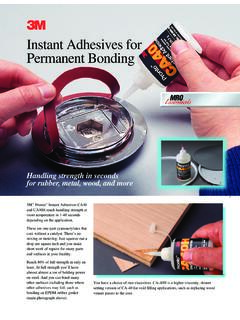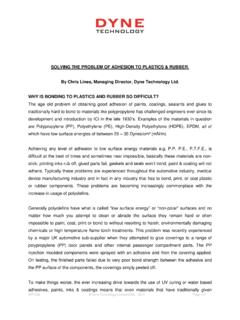Transcription of OFFICE OF NAVAL RESEARCH Contract: N00014-85-K-0222
1 OFFICE OF NAVAL RESEARCH . contract : N00014-85-K-0222 . Work Unit: 4327-555. O Scientific Officer: Dr. Richard S. Miller TO. o Technical Report No. 18. N. PULL-OUT AND PUSH-OUT LS FOR rubber -TO- metal ADHESION. 0. by A. N. Gent and S. Y. Kaang Institute of Polymer Science D T IC. S~iMA. The University of Akron E LECT E. ' U. Akron, Ohio 44325. May, 1989. 989. Hz4~. Reproduction in whole or in part is permitted for any purpose of the United States Government Approved for public release; distribution unrestricted.
2 Ll I I I m il -, .'. SECURITY CLASSIFICATION OF THIS PAGE (VWlmo Data Entered). REPORT DOCUMENTATION PAGE BEFORE CSPLUCG ORM. 1. REPORT NUMBER 2. GOVT ACCESSION NO. 3. RECIPIENT'S CATALOG NUMBER. Technical Report No. 18. 4. TITLE (and Subsits) S. TYPE OF REPORT & PERIOD COVERED. Pull-out and Push-out Tests for rubber -to- Technical Report metal Adhesion TechnicalReport 6. PERFORMING ORG. REPORT NUMBER. 7. AUTHOR(@) S. contract OR GRANT NUMSEIte). A. N. Gent and S. Y. Kaang N00014-85-K-0222 . 9. PERFORMING ORGANIZATION NAME AND A'LDRESS t0.
3 !*RC=RAM , TASK. institute of Polymer Science AREA A WORK UNIT NUMBERS. The University of Akron Akron, OH 44325 4327-555. II. CONTROLLING OFFICE NAME AND ADDRESS 12. REPORT DATE. OFFICE of NAVAL RESEARCH May 1989. Power Program 1i. NUMBER OF PAGES. Arlington, VA 22217-5000 26. 14. MONITORING AGENCY NAME A ADDRESS(If differentfrm Confrolling O ffie) 15. SECURITY CLASS. (of Ale report). Unclassified 15a. DECLASSIFICATION/DOWNGRADINrG. SCHEDULE. Is. DISTRIBUTION STATEMENT (of this Reper). According to attached distribution list.
4 Approved for public release; distribution unrestricted. 17. DISTRIBUTION STATEMENT (l Ath abstract onired in Block 20. II dtlerant &am Report). 18. SUPPLEMENTARY NOTES. Submitted for publication in: Surface Science It. KEY WORDS (Continue on rverse side it " a identity' by biech nmnbe). Adhesion, bonding , Compression, Debonding, Failure, Fracture, Friction, rubber , Steel, Tension. 20. TRACT (Continue an rovere aide II noeeoeoay and Identity by block nmimbor). A steel rod embedded in a rubber block can be debonded either by pulling it out or by pushing it out.
5 A comparison is made between the two failure forces. It is shown that friction, aggravated by the tendency of rubber to undergo Poissonian contraction as the block is stretched, makes the pull-out DD , A 1"1, 1473 EDITION OF I NOV 65 IS OBSOLETE. S/H 0102. LF 014. 6601 SECURITY CLASSIFICATION OF THIS PAGE Mal~n Data ). SECURITY CLASSIFICATION OF THIS PAGE (*W'hn Data Entered). force much higher for rods of large diameter, deeply embedded in the block. On the other hand, the push-out experiment is difficult to carry out because of the inherent instability of tall blocks in compression.
6 Thus, pull-out is still the preferred way of measuring adhesion, but the product aL, where a is the rod radius and L the depth of embedment, should be made much smaller than the cross-sectional area of the block in order to minimize frictional contributions to the failure Accession For "I. NTIS (IPA&I. DTIC TAB C3. UnAn ounced [l Justifleat io ByDlsribu AvaI1bil1a _ y o46s S/N 0102- LF. 014- 6601. SECURITY CLASSIFICATION OF THIS PAGE("Whon Dots Enteed). 1. Introduction A pull-out test for adhesion has many advantages.)]
7 In its simplest form, an inextensible rod, cord or fiber is partially embedded in a long elastic block, and the force required to pull the rod out of the block is measured, Figure 1. A debond propagates up the rod, starting at its embedded end. The pull-out force is directly related to the work of breaking the interfacial bond and the work of stretching the block as it becomes detached. If the elastic properties of the block are known, the fracture work per unit area of interface can be calculated (1).
8 Moreover, because the work of fracture is greater for fracture surfaces of greater radius, there is a natural tendency for the failure to remain as close to the interface as possible. Thus, the mechanics of fracture drive the locus of failure towards the interface, even when the bond is strong. In practice, the pull-out force increases when the embedded length is long, and increases continuously as the rod is pulled out, because of friction in the already-detached portions. The additional force can be quite large.
9 Indeed, frictional resistance to pull-out is auto-catalytic: the greater the frictional resistance to pull-out, the greater the tension in the block and the greater the tendency of the material to grip the rod by Poissonian contraction (2). Because of this difficulty, we have carried out a study of debonding in compression, for comparizon. in this case, the block expands and separates from the rod in a radial direction as it detaches from the rod and becomes compressed. Thus, the frictional 3. component should vanish.
10 A comparison of the two experiments should therefore clarify the role of friction in pull-out mechanics. 2. Theoretical considerations An analysis of pull-out forces has been given previously (1,2). For growth of a debond along the rod by a distance dc, work of detachment is required, given by dW 1 = 2uaG a dc where a is the rod radius. In addition, work of deformation is imparted to the newly-debonded portion of the block, given by dW 2 = (F2/ 2AE) dc where F is the pull-out force, A is the cross-sectional area of the block and E is the tensile (Young) modulus of the block material, assumed for simplicity to be linearly elastic.



















